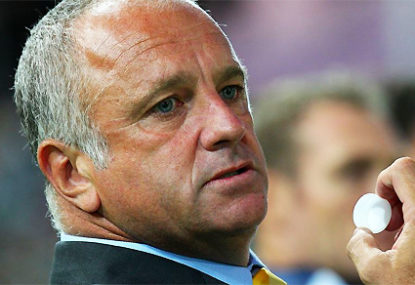On the back of a resurgent season, in which the A-League has had a feel-good factor not seen since the breakout 2006/2007 season, the FFA have confirmed the next Socceroos coach will be Australian.
What has been interesting to this Melburnian is the discourse that has surrounded the impact of the so-called ‘Western Sydney Wanderers’ phenomenon.
It has not escaped my notice a lot of the discussion among football fraternity, from media to fans alike, up in Sydney is how the A-League has never seen anything like the ‘Wanderland’ phenomenon before.
This type of discourse was surprising and not only because it illuminates the degree to which Sydney FC failed to achieve cut-through in the ‘Sydney market’ they were servicing all these years.
Perhaps even more surprising is that illuminates just how much the Sydney-based football media have not properly understood the trends of the game in Melbourne, let alone in other cities, and does nothing to dispel the suspicion they are rather ‘out of touch’ with sections of the greater Australian football fraternity.
Trends that occur in Sydney and New South Wales are not necessarily a reflection of trends nationwide as far as the football fraternity are concerned.
A more true reflection would be to state the Western Sydney have revolutionised the professional game in greater New South Wales.
Which brings me to the next point; by the end of the 2011-2012 season, despite the shot in the arm provided by Harry Kewell, gone were the days a 32,000 strong crowd turned up in Melbourne to watch a ‘non-marquee’ Melbourne Victory versus Perth Glory regular fixture at the beginning of the 2007/2008 season.
The resurgence of the A-League occurring in Melbourne throughout the 2012-2013 season had not so much anything to do with the knock-on impact of Western Sydney Wanderers but rather can be attributed to the impact of a certain Ange Postecoglou.
This was helped by the expansion of a new paradigm of fan management that nurtured the re-flourishing of the North Terrace and, by extension, the greater atmosphere and theatrical nature of games following its once unimaginable collapse at the end of the 2010-2011 season.
This is all relevant to the current debate over who should take over the current Socceroos coaching role.
A-League boss Damien De Bohun’s assertion the A League can smoothly accommodate the loss of either Ange Postecoglou or Graham Arnold (I would add Tony Popovich to that mix as well) is debateable.
One can be forgiven at times for thinking the Australian Football fraternity are still stuck in 2006. Not only that, it seems many have to get to grips with the fact it is only the very top elite footballing powers that are able to be consistent.
It needs to be recognised what happened at the 2006 World Cup was Australia went from a ‘backwater’ to a ‘middle power’, not an elite power.
It is not exactly uncommon that middle powers will often fluctuate between having a generation which is able to qualify for a clutch of major tournaments then fade away into relative obscurity for a generation.
The importance the A-League takes on then becomes even more paramount, as lean years in the national team fortunes can be offset with healthy interest at domestic league level.
The FFA taking Ange Postecoglou out of Melbourne will be delivering a sucker punch to the game’s resurgence in that part of the country.
As for Graham Arnold, while the Mariners crowds are relatively low, it is what they are building at grassroots levels in terms of the Centre of Excellence which is where Central Coast are making their revolutionary contribution to the game.
Given Graham Arnold’s career experience with working with up and coming players, such as the U23 Olyroos, he has an important role in ensuring the fledgling Academy is a success to the point where other A-League clubs follow suit and develop their own versions.
It is best for the game locally and the FFA shouldn’t be rushing to encourage him to leave.
Ange Postecolgou and Graham Arnold have both established a good track record at nurturing youngsters through and setting them up to succeed and break through at high calibre European level.
This is opposed to falling by the wayside and then chasing the money in Asia instead once players realise they can’t cut it at European level.
Both are of better value to the Australian football fraternity at domestic league level as opposed to national team level, where they have to pick from the increasingly shallow talent pool being developed, rather than contribute towards it.
That is without going into the fact that the hubris infecting the football fraternity regarding the A-League is leading fans and pundits alike to get ahead of themselves.
They are skipping an evolutionary step.
In order to be ready for the Socceroos job, an Australian coach must not only be successfully domestically, but will have to have cut their teeth on the continent – either Asia or Europe.
For example, the now much-maligned Holger Osieck had coached Asian powerhouse Urawa Red Diamonds and led them to AFC Champions League glory in 2007 as part of his CV.
How many Australian coaches would be considered for the Urawa hotseat if it became available?
How many would be able to coach teams to Asian Champions League glory, let alone their respective domestic leagues?
In the upcoming years, the need for a healthy domestic competition will be greater than at any time in the league’s preceding eight-year history to compensate for the national team’s undeniable generational decline.
Every care should be taken that it isn’t undermined.





























































































